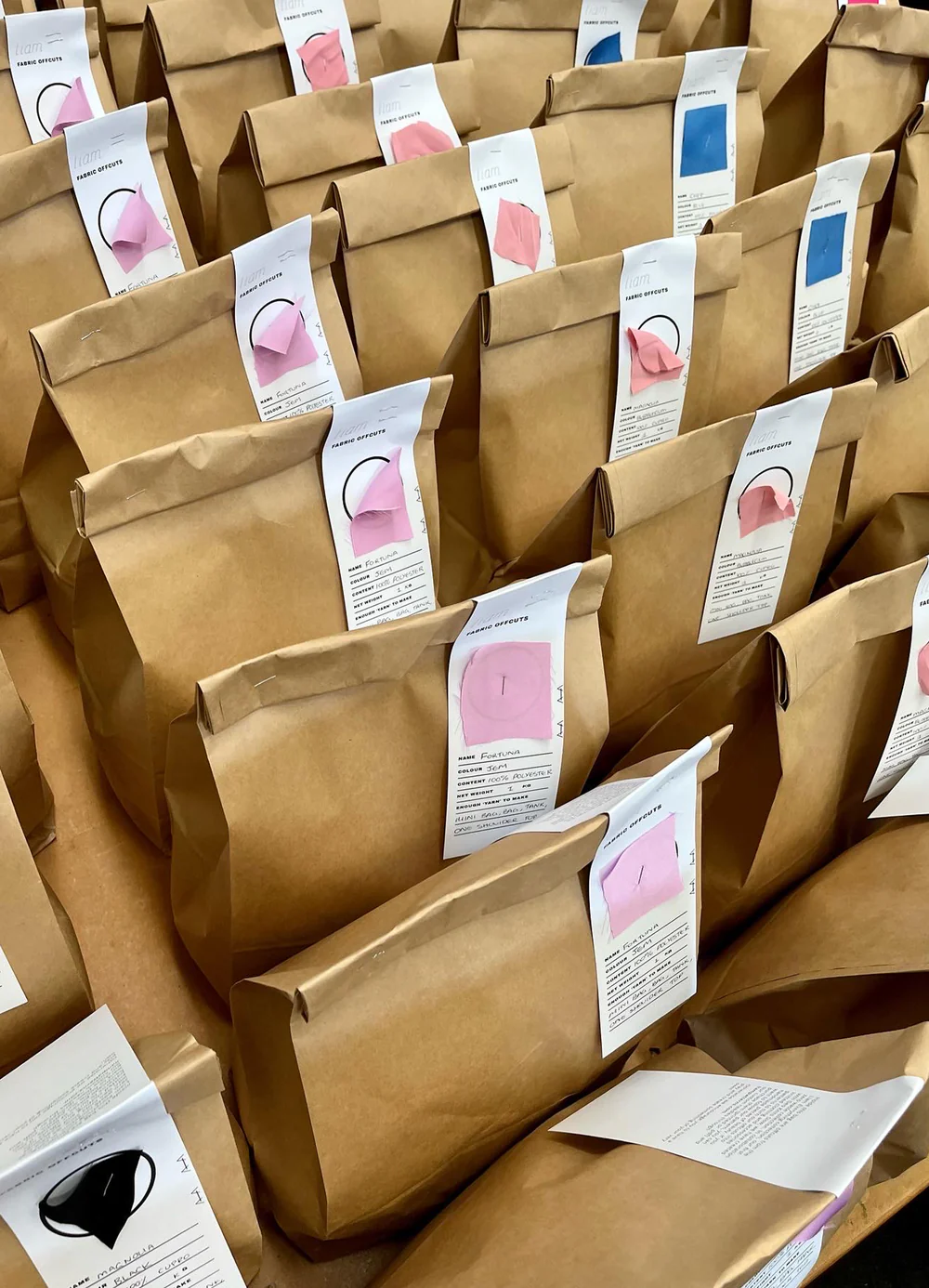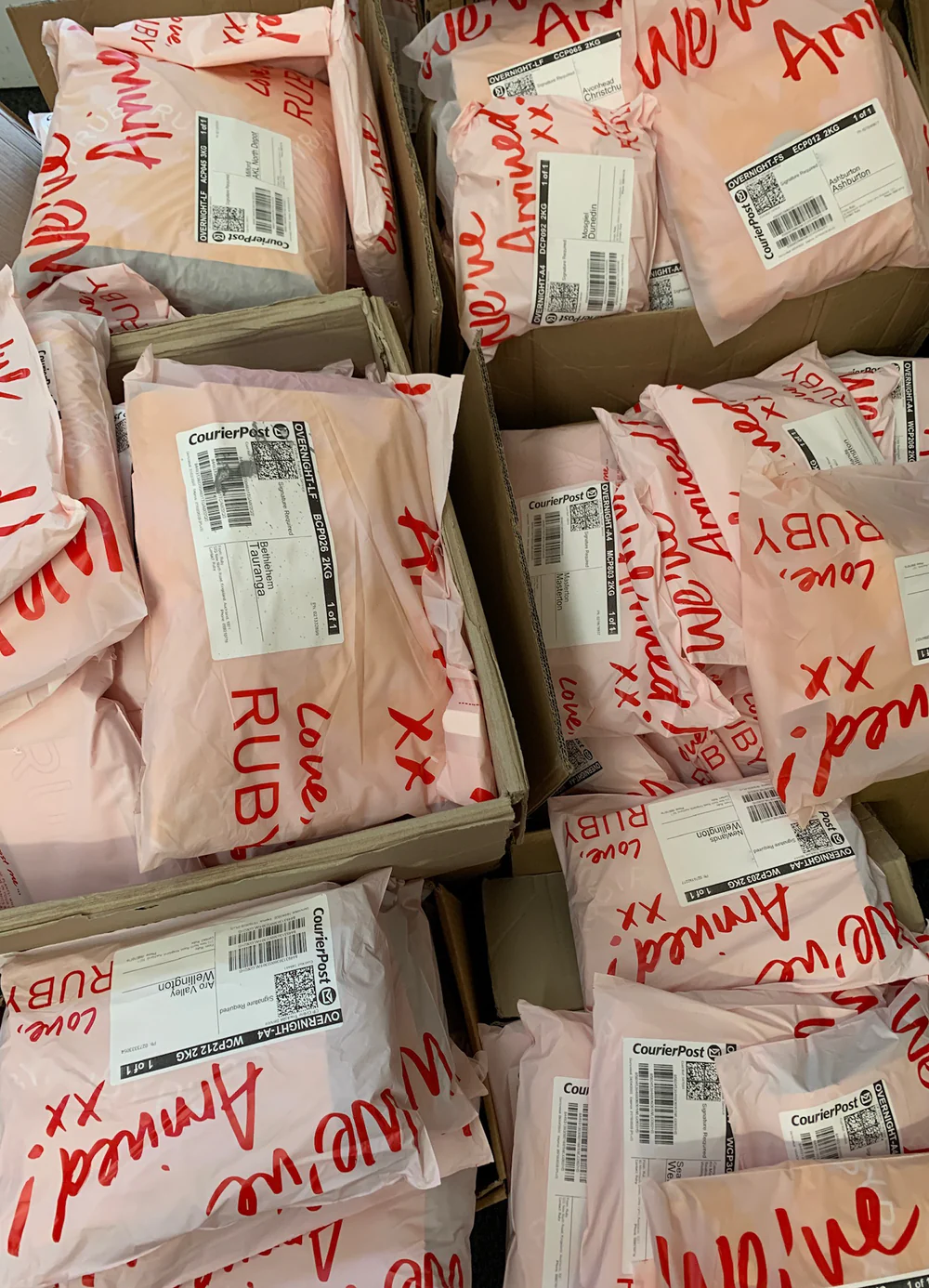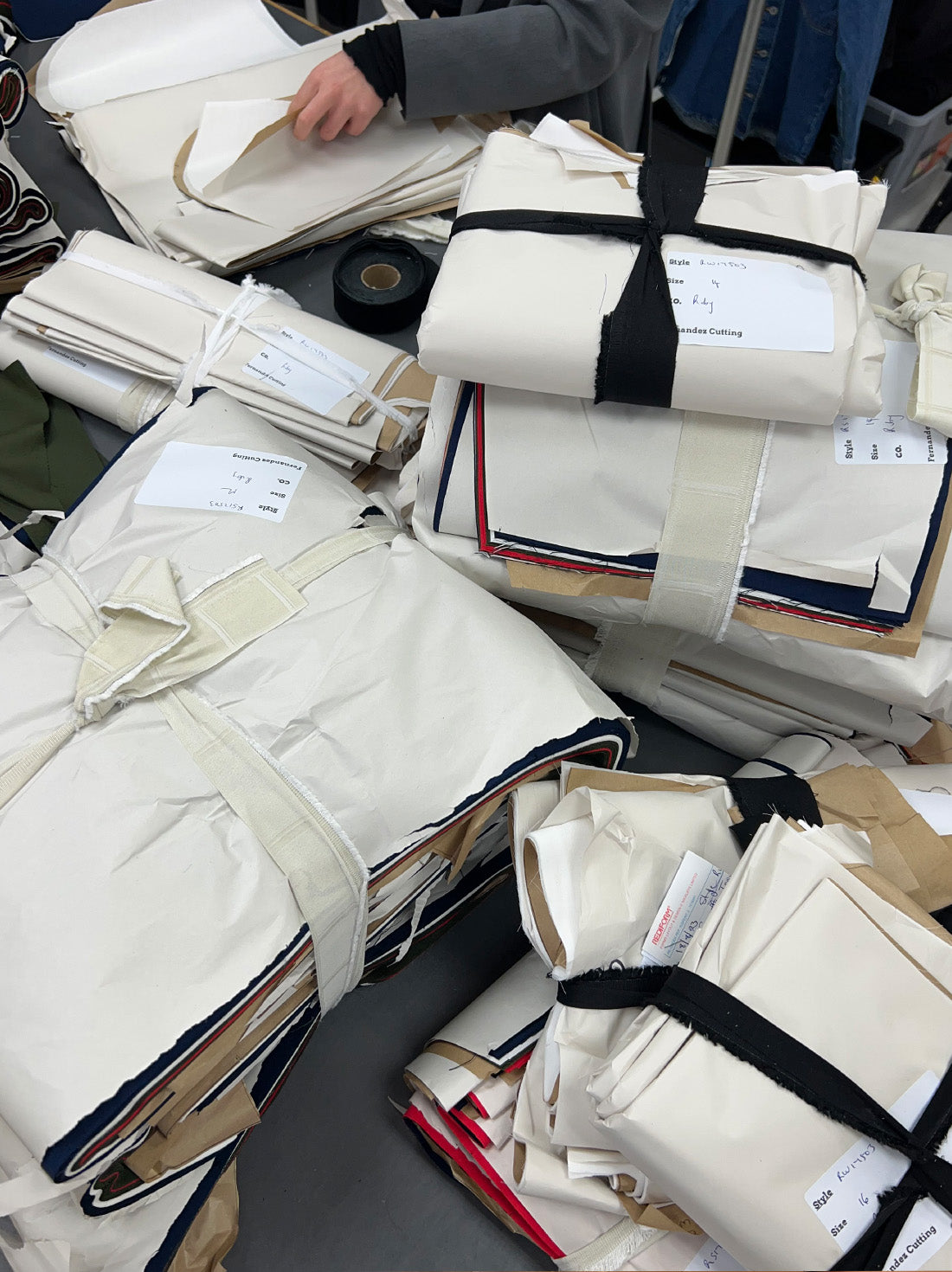Toolbox / Clothing Care
Clothing Care
We want you to love and cherish your RUBY pieces for years to come. One of the best ways to preserve and extend the life of your clothing, is to wash and care for your clothes more mindfully.

When we take care of our clothes, we extend their lifespan. Giving our clothes a longer active wear time means we can enjoy our special pieces for longer and, according to The Wrap UK, extending the active use of a piece of clothing by nine extra months can reduce it’s environmental impact by 20-30%.
We've compiled some of our top tips for how to look after your RUBY pieces. Always remember to read the care label on your garment for specific care instructions.
top tips
- 1
WASH LESS
Over washing can reduce a garments lifespan by causing issues such as pilling, abrasion, loss of colour and holes. Some clothing benefits more from being aired out and spot cleaned, such as cashmere or wool sweaters. Less washing also means less water and electricity use. Who doesn’t love doing less laundry!
- 2
REMOVE STAINS IMMEDIATELY
Rather than letting marks settle into the fibres, for a better chance of keeping your garments looking fresh. Some marks may dissolve with water, but tougher stains may require products such as sard or vanish stain remover. There are also some natural plant-based options available. We recommend patch testing on fabrics before use.
- 3
WASH COLD
When it comes time to wash, wash cold. Water in combination with heat can weaken textiles. In most cases, 30 degrees Celsius is sufficient for washing your clothes.
- 4
WASH INSIDE OUT
To protect the outside of the garment from friction in the washing machine, wash inside out.
- 5
ZIP UP
When washing clothing with zips, ensure the zip is fully closed as the teeth can weaken when getting tangled with other garments. This also stops the zip from catching on other items in the wash.
- 6
UNBUTTON
Wash clothing with the buttons undone, as the stress of the wash cycle can cause threads to loosen when done up.
- 7
PROTECT THE WEAKEST LINK
When washing clothing that contains more than one textile - for example a shirt made from 60% cotton, 40% silk - follow the care instructions for the most delicate fibre listed.
- 8
LIKE WITH LIKE
Wash soft items with soft items. Separating clothes with hard and soft surfaces reduces friction, which in turn reduces fibre breakage. The same applies for overfilling the washing machine. A jammed wash cycle means more friction between your beloved clothes.
Wash brights and darks with like colours to protect other items and to keep the vibrancy in fabrics. This is particularly important when washing new clothing as the dye settles after a few washes. - 9
USE A GUPPY BAG
When washing clothing made of synthetic fibres such as polyester or nylon, use a guppyfriend washing bag. This will help to collect the micro-fibres that would usually enter waterways.!
- 10
USE YOUR HANDS
Often delicate items are labelled ‘dry clean only’. For example, most silk and knitwear items may be washed at home on a cold hand wash cycle or by cold hand washing in a sink or bucket. When using these methods, opt for gentle liquid detergent, and then lay the garment out to dry flat on a towel. We recommend patch testing before trying either of these alternatives (for example the back hem of a dress, or the underarm of a sleeve to check to see what happens when you hand wash) as silk may shrink or lose lustre. Make sure to check the care label for shrinkage advice.
Less drycleaning = less toxic chemicals and plastic garment wraps!
We recommend following the care label instructions for coats and tailored jackets as water may damage the fabric and structure of the garment. Reach out to our team if you need guidance on particular products and we will be happy to help! - 11
ECO-DRYCLEAN
When drycleaning is essential for stubborn stains or for cleaning items such as coats and tailored jackets, we recommend visiting a drycleaner that uses eco-friendly ingredients and methods.
- 12
DRY SMARTER NOT HARDER
To avoid ironing or steaming after washing, remove garment from the wash immediately, shake & pull to shape and then hang on a coat hanger to dry. This will save you time and energy!
- 13
AIR DRY IN THE SHADE
Conventional dryers use heat and motion to dry your garments which requires large amounts of electricity and has a negative impact on the quality of the fabric.
Sun can damage delicate fibres causing bleach marks and fading. Hanging garments to dry in the shade and in a ventilated area can extend the life of your garment. - 14
KEEP IT IN SHAPE
When drying knitwear, gently roll the garment in a towel to remove excess water, then lay flat to dry in the shade. Do not wring or twist your wet knitwear as this can cause the fibres to stretch and garment to mis-shape.
See our how to care for your wool knitwear video below. - 15
STORE WELL
Particularly knitwear. Store clothing in a cool and dry space away from sunlight to prevent clothing from becoming damp, mouldy or sun damaged. Ensure clothing is clean before packing away as this can attract moths which damage fabrics.
- 16
DE-LINT
Treat knitwear and wool clothing with extra care. If bobbles appear on the surface of the fabric, use our RUBY Wool Comb to gently remove bobbles from your coat or sweater. This will give it a fresh look!
- 17
TAKE NOTE
Take care to read special care instructions on care labels and swing tags. These instructions may mention if extra care is to be taken such as; if fabrics are delicate to avoid rough or sharp surfaces and to take care when wearing jewellery. If seams are likely to slip if worn too tight or put under extra tension. To take care when wearing light coloured clothing and accessories with indigo dye garments as there could be a chance for the dye to transfer. If there is a small percentage of shrinkage in the fabric when washing.
- 18
MEND ME
If you have lost a button, or your loved piece ends up with a small tear, find a local tailor who can fix this for you, or teach yourself some new skills through watching YouTube videos or attending a community sewing class. This will help you to extend the life of your garment and get many more wears out of your favourite pieces.
- 19
GET CREATIVE
Try altering or upcycling clothing to give it a new lease on life. Community workshops are a great way to collaborate with others, learn new skills and to inspire your creativity.

care tips for your favourites <3


A variety of fibres are used in our knitwear pieces, such as Viscose, Tencel, Cotton as well as animal fibres like Lamb’s Wool, Merino, Mohair, Cashmere, Alpaca and Yak. Additionally, synthetic fibres such as Polyester, Nylon, and Spandex are often blended with other fibres to enhance stability, stretch, and recovery.
Here are some tips to help extend the life of your knitwear and keep it looking fresh for longer!
Knitwear does not need to be washed frequently. Over washing can cause friction on the fibres causing pilling and bobbling on the surface. Instead, we recommend:
- Airing your knitwear between wears.
- For small stains and odours, spot clean by blotting, not rubbing, with a little delicate liquid laundry detergent and water. Leave to air dry.
- When washing is necessary, follow the steps below.
Washing Instructions:
- Gently hand wash in cold water using a mild liquid detergent. Use a liquid wool detergent for knitwear that contains animal fibres.
- Do not soak or leave wet as this can cause damage such as fibre weakening, distortion, shrinkage, mildew, odour, colour bleeding and colour fading.
- Avoid harsh chemicals, bleach and fabric softeners as they can weaken fibres and cause damage.
- We only recommend drycleaning wool and cashmere. Nylon and Spandex do not like high temperatures, so do not dry-clean knitwear that contains these fibres.
Drying Instructions:
- Never wring out knitwear as this can stretch and distort the shape of your piece.
- Lay your piece flat on a towel, and gently roll the towel to press out excess water.
- Reshape while damp. Smooth out wrinkles and gently reshape the garment to its original size.
- We recommend laying your piece flat to dry on a clean towel in the shade.
Storage:
- Hanging can cause stretching and distortion, as well as holes so avoid hanging your pieces.
- To maintain the shape and protect your piece, store folded flat.
- For long term storage, ensure your piece is clean and store in a cool, dry, ventilated area with natural repellents. Use cedar balls or lavender sachets to deter moths.
Maintenance:
Knitwear pilling is normal, especially for loosely spun yarns and animal fibres. Loosely spun fibres pill when they are exposed to friction during washing and wearing. Here are some tips to maintain the look of your piece:
- Minimise friction: pilling occurs naturally over time. Reduce friction by avoiding heavy bags and rough surfaces.
- Use a Wool Comb: test a small area first. Lay your piece flat and gently and lightly glide the wool comb over the surface in one direction using short strokes. Shop here: WOOL COMB NATURAL | RUBY
- Rest: it is important to let wool garments rest between wears for at least 24 hours. This gives the natural spring in the wool fibre time to recover and return to its original shape.


Our denim is crafted from 100% cotton, a durable and versatile fabric created by tightly spinning and weaving the yarns into a twill weave.
Because cotton naturally lacks elasticity, denim will gradually expand as you wear it, causing your jeans to relax and feel about half a size larger. After washing, the fibres shrink back into place, making the fabric feel tighter and stiffer until it moulds to your body again with wear. If you are in-between sizes, you may want to consider sizing down to account for the fabric relaxing.
Denim undergoes various dyeing and washing processes to achieve unique shades, finishes and textures. Traditional blue denim is dyed with indigo, and it goes through different wash methods to create different finishes and different shades of blue- such colours as our unwashed, ink, indigo, ranger, midtown blue, and light blue.
Our unwashed denim goes through a very light wash, which means it retains more dye than lighter blue tones. As a result, it is more prone to colour transfer. To minimise this, we recommend washing and wearing with dark colours. This shade is also more susceptible to fading with frequent washing. To preserve its rich colour, follow our gentle care instructions and wash as infrequently as possible.
Follow these simple steps to keep your denim in great shape for years to come!
Wash Less, Wear More:
Denim is a durable and breathable material that does not need to be washed often. Washing too often can break down fibres and fade the colour. Instead, spot clean stains, steam and air out your denim between wears. When washing is necessary, follow the steps below.
Turn Inside Out When Washing:
To preserve the colour and reduce friction, ensure the zip is fully closed and turn your denim inside out washing on a gentle cycle. This helps prevent unnecessary fading and wear.
Wash Dark and Light Colours Separately:
Never wash light coloured garments with indigo or coloured denim as dyes may be released through the wash cycle and stain light colours.
Washing Instructions:
Hot water can cause shrinking and fading. Always opt for cold water and a gentle detergent to keep your denim looking fresh. Avoid soaking and using fabric softeners and bleaches, which can weaken the fibres.
Drying Instructions:
Heat can shrink and weaken denim fibres of denim. Instead, air dry your denim by laying it flat or by hanging to dry in the shade. Hanging your denim to dry in the sun can fade the colour and cause bleach marks on the fabric.
Ironing:
If your denim gets wrinkled or creased, use a warm iron or steamer to smooth it out. Avoid excessive heat, and iron inside out to protect the fabric and colours.
Storage:
Fold jeans neatly or hang them by the waistband to maintain their shape. Store them with good air flow to preserve the integrity of the denim and prevent musty odours.
Wearing:
Do not pull on the belt loops of your jeans as this can weaken and damage the fabric over time.
Always button your short, jean or skirt button first before zipping up the fly to prevent strain on the zipper and fabric.
Additionally, be mindful of sharp objects or rough surfaces that could cause snags or tears in the denim.


A signature RUBY wardrobe staple! Our Firebird Pants are crafted from 80% Acetate, a semi-synthetic fibre, and 20% polyester, a synthetic fibre. Acetate is a delicate fibre, so everyday wear may impact its durability over time. These fibres are also sensitive to high temperatures so take care during the washing process.
Here are some tips to extend the life of your Firebird Pants.
Washing Instructions:
- Air between wear to avoid unnecessary cleaning. These pants should not require washing after every wear.
- For small stains and odours, spot clean by blotting, not rubbing, with a little delicate liquid laundry detergent and water. Leave to air dry.
- Ensure to zip up before washing. This helps maintain the integrity of the zipper and prevents snagging.
- Wash with other similar colours and textures to avoid colour transfer and snagging.
- Cold hand wash or cold gentle machine wash using a mild detergent.
- Avoid harsh chemicals and fabric softeners as this can weaken and damage the fibres.
- Avoid washing detergent that contains optical whiteners and brighteners as this may damage the fabric.
- Do not soak or leave wet as this can cause damage such as fibre weakening, distortion, shrinkage, mildew, odour, colour bleeding and colour fading.
- These pants are dry-cleanable if required.
Drying Instructions:
- Do not tumble dry as this can cause shrinkage and damage the quality of the fabric.
- Remove garment from the wash immediately, shake and pull to shape and then hang on a coat hanger to dry. This will help to remove excess wrinkles and creases.
- Hang to dry in the shade. Direct sun may cause damage such as bleach marks.
Ironing:
- To iron out wrinkles, opt for steaming over pressing. You can use a little water with the steamer which helps to relax and smooth out creases.
- If pressing is necessary, use a cool setting and iron on the reverse side of the garment to avoid marking. You can also use a thin piece of cotton or tea towel as a pressing cloth between the iron and garment.
Maintenance:
Thinning of the fabric can occur over time due to friction, particularly in areas that experience frequent rubbing. Here are some recommendations to help prevent and manage this:
- Minimise friction by avoiding heavy bags and rough surfaces.
- Reinforce areas such as the inner thighs. Sew or iron on a protective layer on the inside the for extra durability.


Another RUBY favourite is our Corvette Pants which are made from 88% Viscose, 12% Nylon. Viscose is sensitive to high temperatures and can shrink if exposed to heat.
While these pants offer the effortless style of a casual pant, they’re made from a delicate fabric that requires a bit of extra care to preserve their appearance. Here are our recommendations.
Washing Instructions:
- Air between wear to avoid unnecessary cleaning. These pants should not require washing after every wear.
- For small stains and odours, spot clean by blotting, not rubbing, with a little delicate liquid laundry detergent and water. Leave to air dry.
- Wash with other similar colours and textures to avoid colour transfer and snagging.
- Cold hand wash or cold gentle machine wash using a mild detergent inside out with the tie ends protected inside the garment.
- Avoid harsh chemicals as this can weaken and damage the fibres.
- Avoid washing detergent that contains optical whiteners and brighteners as this may damage the fabric.
- Do not soak or leave wet as this can ruin the pristine whiteness of the side stripes, and cause damage such as fibre weakening, distortion, shrinkage, mildew, odour, and colour fading.
- These pants can be dry-cleaned but we recommend following the above instructions over this option.
Drying Instructions:
- Do not tumble dry as this can cause shrinkage and damage the quality of the fabric.
- Remove garment from the wash immediately, shake and pull to shape and then hang on a coat hanger to dry. This will help to remove excess wrinkles and creases.
- Hang to dry in the shade. Direct sun may cause damage such as bleach marks.
Ironing:
- To iron out wrinkles, opt for steaming over pressing. You can use a little water with the steamer which helps to relax and smooth out creases.
- If pressing is necessary, use a cool setting and iron on the reverse side of the garment to avoid marking. You can also use a thin piece of cotton or tea towel as a pressing cloth between the iron and garment.
Maintenance:
Due to the nature of this fabric, bobbles may form with frequent rubbing. Here are some recommendations to help prevent and manage this:
- Minimise friction by avoiding heavy bags and rough surfaces.
- We recommend de-linting with a wool comb. Test a small area first. Lay your piece flat and gently and lightly glide the wool comb over the surface in one direction using short strokes. Shop here: WOOL COMB NATURAL | RUBY


Our towels are made of a high-quality cotton. Please follow these care instructions to keep your towel in top condition:
- We recommend washing your towel before use to soften, enhance absorbency as well as reduce the risk of yarn pulling.
- Wash with other similar items and similar colours.
- Gentle machine wash on a cool cycle, 30 degrees or below to avoid fluffing after wash.
- Do not use harsh chemicals and detergents to wash, such as bleach.
- Do not soak or leave wet for a long period of time.
- Line dry in shade. Alternatively, you can tumble dry on a cool setting 30 degrees or below.
- Avoid chemicals and skincare that may discolour your towel.
- Take care with sharp objects and jewellery to avoid yarn from pulling.

tips by fabric type


To extend the life of your cotton garment, we recommend airing after use to avoid unnecessary washing. For small stains, spot clean with delicate laundry detergent and leave to air dry. For deeper cleaning, we recommend delicate cold hand or machine wash with similar colours. Do not soak, bleach or tumble dry. Hang to dry in shade. Cool iron on reverse if required. Please allow 3-5% for shrinkage. Cotton can also be dry-cleaned.


To extend the life of your cupro garment, we recommend airing after use to avoid unnecessary washing. For light cleaning, we recommend spot cleaning with laundry detergent then leaving to air dry. For deeper cleaning, we recommend cold delicate machine wash in a garment bag then line dry in the shade. Cold iron on reverse if required. Cupro can also be dry cleaned. Please allow for 3-5% shrinkage. Do not soak, wring, bleach or tumble dry.


To extend the life of your linen garment, we recommend airing after use to avoid unnecessary washing. For small stains, spot clean with laundry detergent and leave to air dry. For deeper cleaning, we recommend a cold delicate hand wash or machine wash with similar colours then hang dry in shade. To press out wrinkles, we recommend cool iron on the reverse only. Linen can also be dry cleaned. Please allow for 3-5% shrinkage. Do not soak, bleach or tumble dry.


To extend the life of your polyester garment, we recommend airing it after use to avoid unnecessary washing. For small stains, spot clean with laundry detergent and leave to air dry. For deeper cleaning, cold delicate hand wash then hang to dry in shade away from direct sunlight. Do not soak, bleach, wring, or tumble dry. Cold iron on reverse if required. Polyester is also dry cleanable.


To extend the life of your silk garment, we recommend airing it after use to avoid unnecessary washing. For deeper cleaning, we recommend dry clean only.
Please allow for 3-5% shrinkage if you choose to cold hand wash.


To extend the life of viscose or rayon garment, we recommend airing it after use to avoid unnecessary washing. For small stains, spot clean with delicate laundry detergent and leave to air dry. For deeper cleaning, we recommend a cold delicate hand wash or machine wash in a garment bag. Do not leave to soak or leave it damp, dry on hanger in the shade without delay. Warm iron on reverse if required. Viscose and rayon can also be dry cleaned.
Find out more
Reached the end of this care guide and you'd still like a little more help on the best way to care for your RUBY or Liam garment? Get in touch!
Product
The work and care we put into our product so that each piece is loved for a long time and by many.

Community
We believe in strengthening & educating our local community whether that be those in our team, Rubettes that frequent our stores or those we haven’t met yet.

Carbon Curious
Insights into our carbon footprint and the plan to reduce our emissions.

Product
Community
Carbon Curious
Education
Product

Community

Carbon Curious

Education






















